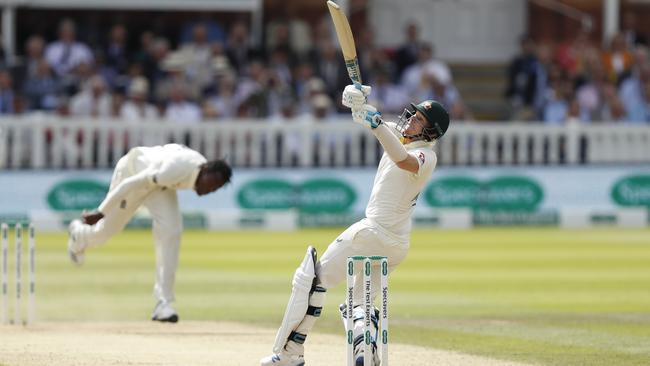Ashes 2019: Ian Chappell’s plan to make batting safer
Former Test skipper Ian Chappell has two simple solutions to avoid being hit — watch the ball and use your bat.

Every cricket expert — and a few non-cricketing experts — have volunteered their opinion about dangerous short bowling in the days since Steve Smith was felled by Jofra Archer at Lord’s.
Ex-Wallaby Peter FitzSimons tossed his bandana in the ring yesterday when he urged the authorities to consider banning the bouncer.
“Should it be permissible?” FitzSimons asked on Channel 9. “In other sports — rugby union, rugby league, AFL — attacking above the head — off you go, sent from the field.” FitzSimons undermines his case by confusing Australian football’s peak competition with the sport, but never mind, his contribution is more grist for the bouncer mill.
Anyway, what would Bradman say about all this? If The Don was available, his phone in Adelaide’s leafy east would be running hot while shady figures with ‘‘press’’ on their fedoras clamoured at the gates.
What’s the answer to this short stuff Don? To watch the ball, of course. And get out of the way when hooking.
“Make sure you swing the body out of the line to avoid the risk of injury,” Bradman said in his coaching film, How to Play Cricket.
“Concentration is the keynote to success. And to be a successful batsman, you must watch the ball. I can’t impress these things too much. Watch the ball and concentrate.”
Now you might say Bradman didn’t like the short stuff too much, what with Bodyline and all that. But players who enjoy a bouncer barrage are as thin on the ground as Australian centuries not made by Steve Smith. (Incidentally, Bradman averaged a measly 57 in the Bodyline series. Without a helmet.)
Bradman might be unavailable, but we are fortunate to have the next best thing. Ian Chappell.
They might not have agreed on everything, but The Don and Chappelli are of one voice when it comes to bouncers. Watch the ball.
“He took his eye off the ball,” Chappell told Macquarie Sports Radio this week when asked about the Smith incident. “Don’t go ducking balls. As soon as you duck you take your eye off the ball.”
Chappell argues that many modern batsmen don’t have the technique to play the dangerous short ball.
“Here’s the lack of common sense that astounds me so often with cricket administrators,” he said. “When Phillip Hughes sadly was killed with a cricket ball … Cricket Australia decided to have a safety review.
“And I spoke to (ex-CA chief executive) James Sutherland and I said ‘James, does that include technique?’ The answer came back: ‘No it doesn’t include technique.’
“Well that’s ridiculous. The best way to avoid getting hit is to get your technique right.”
Chappell advises quickly getting into position to hook or pull. “At the last second if it’s too high, if it’s straight at your head, it’s amazing how quickly you can get your head out of the way if you’re watching the ball.”
The former Australian skipper will no doubt be dismissed in some quarters as a dinosaur, but all those critics are doing is drawing attention to their own naivety.
Five of Chappell’s 14 Test hundreds came against the West Indies’ pacemen.
And aged 34, he made 141 against the Windies in a Supertest at Football Park, Adelaide in 1977.
Cosseted within head protection totalling one cap, canary yellow, Chappell hooked and pulled Michael Holding, Andy Roberts and Joel Garner to the long boundaries of the former football stadium.
He was hit once — when a Roy Fredericks throw at the stumps flew into the back of the master’s head. Chappell rubbed it for a moment before resuming his assault on the Windies pacemen.
“My advice is … the best piece of protective equipment is that wooden thing you’ve got in your hands,” Chappell said. “You hit the bloody ball and it won’t hit you.”
Counterintuitively, the coming of helmets has led to more players getting hit.
The safety they provide means players don’t necessarily need to learn how to avoid short balls.
But then a speed merchant in the form of Jofra Archer comes along to call in a debt. You’ve had it your own way too long, Archer seems to be saying between cackles as he sends another ball flying past a probing bat.
You’ve profited from your supercharged bats. Your true tracks. Their mediocre attacks.
Amid all the calls for compulsory neck guards, greater bouncer restrictions — or banning it altogether (whereupon the game could be renamed Range-Hitting or better still Throwdowns) — Chappell says there’s another alternative.
Don’t play.
“As harsh as it might sound, every Test cricketer knows that if you don’t want to get hurt, don’t walk through that gate.
“If you walk through that gate there’s a chance you’ll get hurt.
“The responsibility’s got to be on the individual as much as anything, because you can’t make the game totally safe.”



To join the conversation, please log in. Don't have an account? Register
Join the conversation, you are commenting as Logout